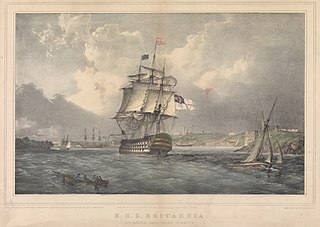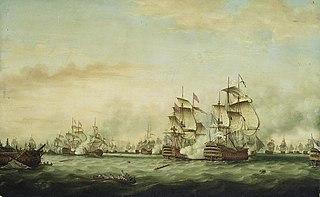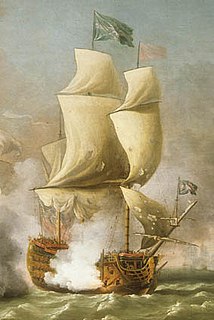Related Research Articles

Several ships of the Royal Navy have borne the name HMS Resolution. However, the first English warship to bear the name Resolution was actually the first rate Prince Royal, which was renamed Resolution in 1650 following the inauguration of the Commonwealth, and continued to bear that name until 1660, when the name Prince Royal was restored. The name Resolution was bestowed on the first of the vessels listed below:
Six ships of the Royal Navy have borne the name HMS St Albans after the English city and ducal family of St Albans:
Five ships of the Royal Navy have been named HMS Exeter after the city of Exeter in Devon.
Seven ships of the Royal Navy have been named HMS Monmouth. Monmouth was the name of a castle and is now the name of a town in Wales; the name also recognises James Scott, 1st Duke of Monmouth, the "Black Duke".
Eight ships of the Royal Navy have been named HMS Royal Oak, after the Royal Oak in which Charles II hid himself during his flight from the country in the English Civil War:
Seven ships of the Royal Navy have been named HMS Royal Sovereign, while another was planned but renamed before being launched:
Nine ships of the Royal Navy have been named HMS Grafton, while another one was planned:
Eight ships of the Royal Navy have been named HMS Devonshire, originally in honour of William Cavendish, 1st Duke of Devonshire, and later after the county of Devonshire.
Twelve ships of the Royal Navy have been named HMS Repulse:
Eight ships and a shore establishment of the Royal Navy have been named HMS Centurion, after the centurions of ancient Rome. A ninth ship was planned but never built. Ships
Six ships and a shore establishment of the Royal Navy have borne the name HMS Britannia, after Britannia, the goddess and personification of Great Britain:
Four ships of the Royal Navy have been named HMS Formidable with a fifth, the French Formidable, renamed HMS Ham after being captured and recommissioned; a sixth has been announced:

HMS Britannia, also known as Old Ironsides, was a 100-gun first-rate ship of the line of the Royal Navy.

HMS Barfleur was a 90-gun second-rate ship of the line of the Royal Navy, designed by Sir Thomas Slade on the lines of the 100-gun ship Royal William, and launched at Chatham Dockyard on 30 July 1768, at a cost of £49,222. In about 1780, she had another eight guns added to her quarterdeck, making her a 98-gun ship; she possessed a crew of approximately 750. Her design class sisters were the Prince George, Princess Royal, and Formidable. She was a ship of long service and many battles.
Several ships of the Royal Navy have been named HMS Dragon.

The Barfleur-class ships of the line were a class of four 90-gun second rates, designed for the Royal Navy by Sir Thomas Slade.
Eight ships of the Royal Navy have been named HMSSt George, after Saint George, the patron saint of England:

HMS Barfleur was a 90-gun second rate ship of the line of the Royal Navy, launched at Deptford Dockyard on 10 August 1697.
Four ships of the Royal Navy have borne the name HMS Seaford, after the coastal town of Seaford, now in East Sussex. A fifth was planned, but was not completed for the navy:
References
- Colledge, J. J.; Warlow, Ben (2006) [1969]. Ships of the Royal Navy: The Complete Record of all Fighting Ships of the Royal Navy (Rev. ed.). London: Chatham Publishing. ISBN 978-1-86176-281-8.